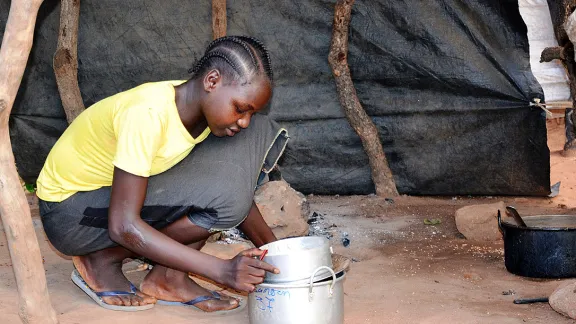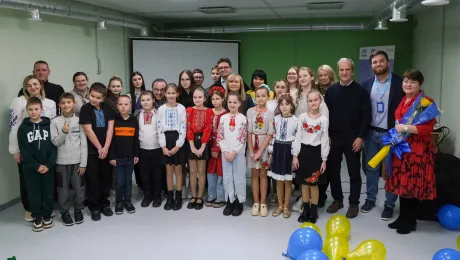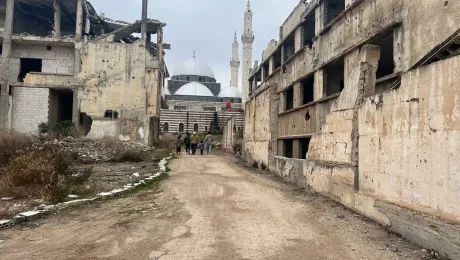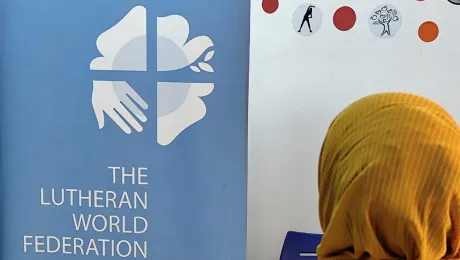
Sudanese refugee Amona Tia prepares the evening meal for her siblings at the Ajuong Thok refugee camp in South Sudan. With help from the LWF, she has resumed schooling. Photo: LWF/A. Kiura
Conflict in South Kordofan causes massive influx to South Sudan's Ajuong Thok refugee camp
AJUONG THOK, South Sudan/ GENEVA, 26 October 2015 (LWI) – “When I left my village in South Kordofan, I wondered how to survive without my parents,” says 15-year-old Amona Tia (not her real name).
The teenager fled conflict in Sudan’s South Kordofan province in January, together with her siblings. They were separated from their parents as they fled to South Sudan. Tia’s 16-year-old sister has become the head of the household, which includes two more sisters and two brothers. The Lutheran World Federation makes sure the children are supported and able to go to school.
The number of children like Tia has doubled in Ajuong Thok refugee camp, just over the border in South Sudan, since a surge in the South Kordofan conflict caused a new influx of refugees.
According to the United Nations’ refugee agency, UNHCR, the refugee population of Ajuong Thok had risen from 18,000 to nearly 31,130 by 20 October. By December the camp is expected to be filled to the capacity of 40,000 people. More than half the residents are children. One third of the total refugee population are children of school-going age. One in 10 children arrives without a parent or adult caregiver.
Scaling up child protection
Being the UN partner for education and child protection in the refugee camp, LWF South Sudan has scaled up activities to meet increased demand. It runs three primary schools and one secondary school, six child-friendly spaces and several child-rights clubs. It facilitates an accelerated learning program that helps older children whose education was interrupted by conflict and war make up for schoolingthey missed.
Through child help desks and child rights clubs, LWF identifies vulnerable children as early as possible. Tia was registered by LWF child protection staff in January at the reception centre in Yida, South Sudan, close to the Sudanese border, before she was moved to a camp. When she arrived in Ajuong Thok, LWF staff made sure she and her siblings were enrolled in school, and received books, sandals, clothes, soap and sanitary materials for the girls, together with the food rations provided by the World Food Programme.
Through follow-ups and regular home visits, the family of children is checked regularly. Tia was encouraged to take part in recreational activities and has been linked to other children in one of the peer groups. Through group counseling by LWF the children are able to mix with each other share.
Difficult school situation
Like many children in the camp, Tia has embraced the opportunity for education. Initially enrolled at a local primary school, Merowe, she was later moved to another primary school as the camp filled up. This was helpful, as the school is closer to home and the children can attend sessions at different times. Tia and her brother learn in the morning, while her sisters attend the accelerated learning program in the afternoon. The arrangement has helped the children continue learning while they share household chores and look after each other.
Still, conditions are far from ideal, as team leader Anne Mwaura points out. “Merowe Primary school currently holds 2583 children in 21 classrooms – a ratio of one to 123 students,” she says. Most of classrooms are improvised tents made from plastic sheets and pieces of wood, which LWF obtainedfrom UN agencies. South Sudanese standards allow for up to 50 students a class. “The situation is worse in terms of sanitation,” Mwaura says. The school has three latrines for boys and three for girls. This means up to 500 students have to share one toilet. “School children are forced to learn in congested classrooms, share text books, sit on mats and use home clothes in place of school uniform,” Mwaura adds.
More effort needed to support refugees
Whereas LWF had planned to support 5400 students in 2015, the number of school-going children almost doubled within three months.
It has built 47 new semi-permanent classrooms and recruited 41 extra teachers from among the refugee population. It has also established simple structures from iron sheets and wooden poles at child-friendly spaces to open up a pre-school learning area for 3000 more children, and trained extra pre-school teachers. Community-based child protection committees, foster care support groups, peer groups and child rights clubs were set up.
With the continued support of local partners and donors, such as the European Commission's humanitarian aid and civil protection department (ECHO), Church of Sweden, UNHCR and the UN Children’s Fund, UNICEF, the LWF team has been able to care for 12,000 children and students in 2015, so far more than twice as many as the projected 5400. Still, needs are far greater than resources. As children like Tia and her siblings continue to arrive in Ajuong Thok, more effort is needed to make sure their situation does not worsen.
Thanks to LWF intervention, Tia can dream again of a bright future. She smiles broadly as she shares her ambition: “I want to be a respected woman in my community,” she says. “I want to complete school and become the president of South Kordofan.”


